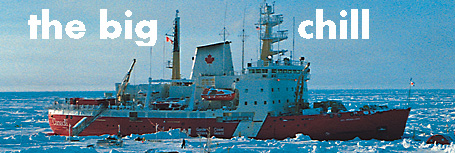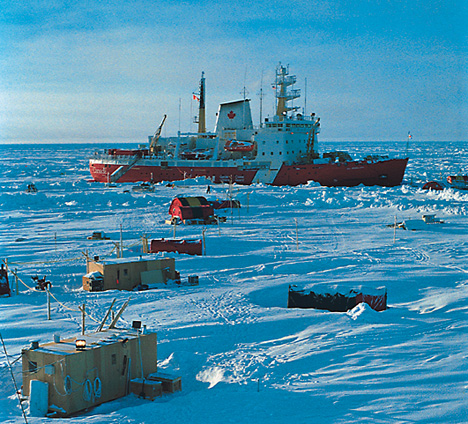

The frozen icebreaker is part of the largest and most complex undertaking ever supported in the Arctic by the National Science Foundation, the $19.5 million SHEBA (Surface Heat Budget of the Arctic Ocean) project. The University of Washington's Applied Physics Laboratory leads the project, which is no surprise since the lab has conducted more than half of all U.S. Arctic ice camps in the last 25 years.
The last ship to sit deliberately in the ice pack was the Fram, a Norwegian vessel that was frozen into the ice in 1893 for the purpose of scientific exploration. The Fram drifted for nearly three years before being able to break free. Canada's Des Groseilliers will be frozen in for a third as long and, come October, will be joined by the Canadian Coast Guard's Louis St. Laurent so that the two icebreakers can work in tandem back toward open water.
Although the icebreaker is hundreds of miles from civilization, it is still well connected to the planet. Satellite links allow for phone, fax and Internet feeds. Small planes and helicopters bring in crew and supplies from Alaska.

An Arctic ice floe holds the Canadian icebreaker Des Groseilliers in its
grip. Research huts dot the ice surface as power lines connect them to the
ship's generator. Photo by Sandra Hines.
On my flight in, the Des Groseilliers was a startling red presence after three hours over snow, ridges of ice and occasional ribbons of open water. The sight prompted a fellow science writer to say it looked like Gulliver tethered in place by the Lilliputians. In this case the ties that bind are power lines running from the ship out to a couple dozen plywood huts, half-barrel-shaped tents and other research structures on the ice.
After we land, we take a tour of the site. Scientists at this ice station are making measurements of clouds, air, snow, ice and the ocean in order to understand how they exchange energy. Researchers are using high-tech gear--an instrument that aims a laser at the sky--to low-tech gear--snow gauges that are glorified yardsticks.
The Arctic ice cap is one of the last unexplored regions of the Earth. We are only beginning to understand the profound changes it experiences over the course of a year: In the winter, the ice pack is about the size of the continental United States; in the summer, there is only half as much ice.
Tracking this meltdown is important if we want to know the toll global warming, either natural or human-based, could have on the region. Warming could, for instance, affect westerly winds and change our weather patterns. It would certainly affect the web of life that ranges from microscopic algae on the sea ice to 1,600-pound polar bears that roam the ice pack, according to Dick Moritz, senior oceanographer with the UW's Applied Physics Laboratory and SHEBA project director.
Knowing the severity of global warming in the Arctic could be a key factor as the world debates its options, which range from doing nothing to taking drastic steps to curtail our production of greenhouse gases.
Current models of the Arctic climate can give vastly different results when considering various scenarios, Moritz says. For instance, some models say doubling the amount of carbon dioxide in the Earth's atmosphere (something scientists fell is likely to happen within the next 50 to 100 years) will make the Arctic ice pack half as large as it is today. Others predict it will disappear completely.
Life on the Ice: Minus 45 Degree Weather and Lobster
Salad
Dangers Include Polar Bears and Ice
Break-Ups
Total Meltdown? Ice Cap Future in
Question
Send a letter to the editor at columns@u.washington.edu.